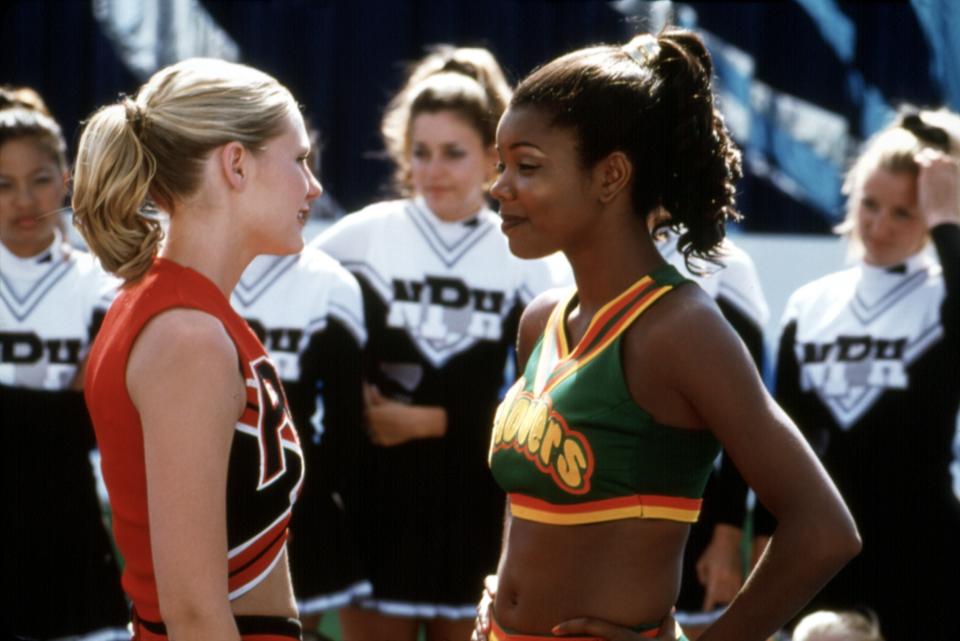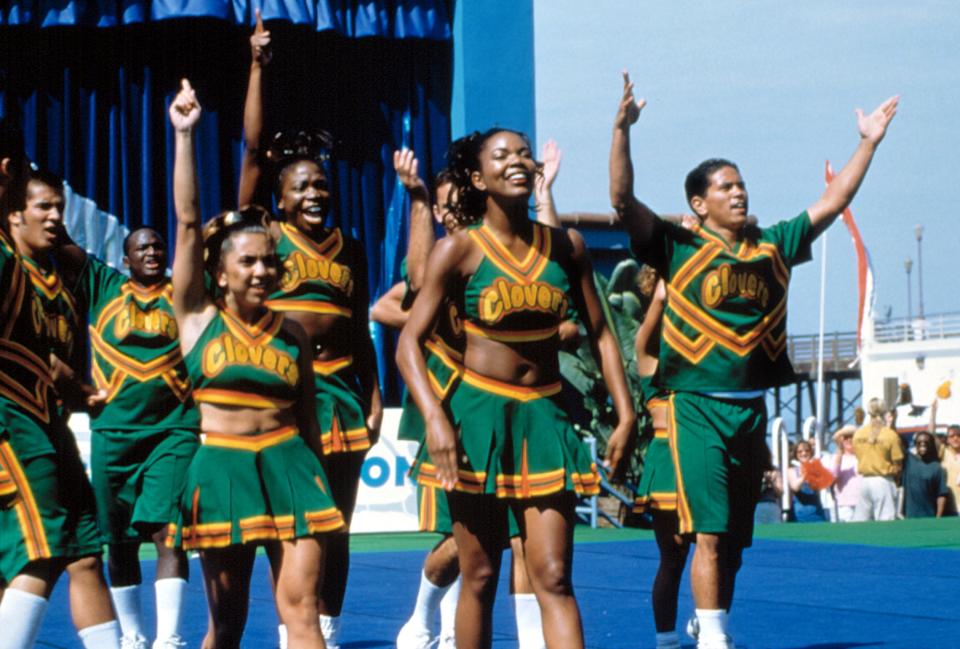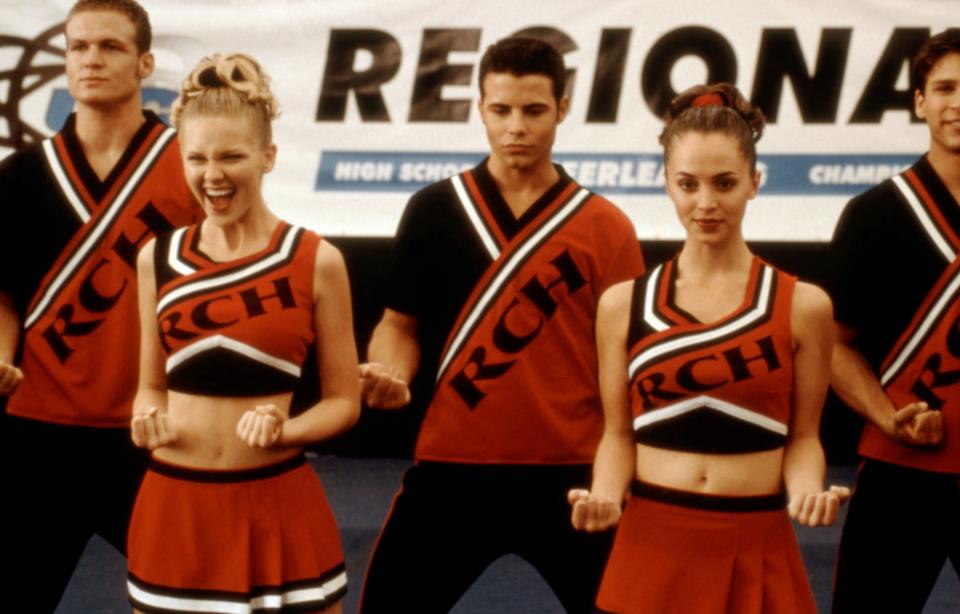Bring It On Still Has Spirit—And a Message—20 Years Later
“Every time we get some, here y’all come trying to steal it, putting some blond hair on it, and calling it something different,” Isis (Gabrielle Union) tells Torrance (Kirsten Dunst) early into Bring It On, the seminal teen classic that turns 20 on August 25.
Isis is talking about cheers—specifically how Torrance’s squad, the mostly white Rancho Carne Toros, has been pilfering routines from the East Compton Clovers (of which Isis, a Black woman, is the captain) for years. It’s a surprisingly effective education on cultural appropriation placed within a whip-smart comedy about competitive high school cheerleaders. That’s the brilliance of Bring It On: It hides its medicine inside the candy, a metaphor both director Peyton Reed and screenwriter Jessica Bendinger used when discussing the film.
“You couldn’t suddenly have a frothy movie take this hard-left turn into these really serious themes,” Reed tells Glamour. “It had to be seeded into the story from the beginning, and how we dealt with it had to be as forward-thinking as possible.”
The seeds for Bring It On were first planted during Bendinger’s college years, after an internship at Spin magazine expanded her worldview. At the time, white rappers like Beastie Boys, Vanilla Ice, and Snow were rising to fame—and generating criticism for profiting off a music genre with deep roots in Black culture. “There were a lot of conversations in music journalism about appropriation,” she says. “I’m not going to know everything because I’m white, but it was very obvious to me from a young age that white culture had always appropriated Black culture.”
She saw this in action while watching a cheerleading competition on ESPN over her Thanksgiving break: The white squads, she noticed, were clearly using hip-hop dance moves.
“I thought, What if a real Black squad came and disrupted this whole thing? I would love that movie.”

BRING IT ON, Kirsten Dunst, Gabrielle Union, 2000
Not everyone agreed. Bendinger pitched her idea 27 times before a small production company, Beacon Pictures, gave her the green light. As she developed the script, Bendinger wanted to seamlessly blend comedy and commentary. She thought back to her Spin days doing back-to-back interviews with Public Enemy and Salt-N-Pepa, two hip-hop acts with drastically different missions. The former had a specific, political message; the latter prioritized entertainment. Bring It On needed to be both. It needed to have medicine inside the candy.
Achieving that wasn’t difficult. Bendinger just wrote the story she dreamed up in her head as authentically as possible. “I honestly wasn’t thinking about [the film’s lofty themes],” she says about how she approached the script. “I was weaving this thing together, trying to make it entertaining and trying to make it as clear as possible.”
“Awesome, oh wow!” was inspired by a female friend, who learned it in college. “Pump your gas someday” was a football chant from Northwestern University. “Brrr, it’s cold in here” is part of a famous Black fraternity step routine.
The entertainment—the candy—came in the form of Bendinger’s natural wit and penchant for puns, which she credits to growing up with a father who worked in advertising. Missy’s (Eliza Dushku) “I transferred from Los Angeles” song and classic lines like “the whore in horrifying” were all excavated from the campiest corners of Bendinger’s mind—one she says was also shaped by her circle of gay friends.
The dialogue in Bring It On is flamboyant and over-the-top. As a gay man, I’'m drawn toward that kind of language—Bendinger is too. “I think having been a teenage girl, only child, divorced parents, no family, around adults a lot, I always gravitated toward the gay friend in the room,” she tells me.
She cites one of Bring It On’s most iconic lines—“You put the itch in bitch”—as an example. “I remember where I was when I thought of it,” she says. She was struggling coming up with a quippy line when she turned to her friend Greg, who was sitting with her. “The way he would turn a phrase! I just said, ‘You put the itch in bitch.’ Everybody [in the room] dropped their jaw and went, ‘Oh, my God, that’s brilliant.’”

BRING IT ON, Gabrielle Union (center), 2000
Another good story: the origin of Bring It On’s opening chant, which, yes, Bendinger wrote herself. She was in New York City and talking with a friend—journalist David Coleman—about a project she was working on about modeling. “I was like, ‘People hate models. People hate them on sight. They’re thin, they’re beautiful….’” His response? “Hate us because we’re beautiful? Well, we don’t like you either.”
She adds, “I wrote it down and never forgot it.”
Of course, Bendinger was also influenced by actual cheers she'd pulled both from memory as well as her research. “Awesome, oh wow!” was inspired by a female friend, who learned it in college. "Pump your gas someday" was a football chant from Northwestern University. “Brrr, it's cold in here" is part of a famous Black fraternity step routine.
Bendinger’s screenplay eventually landed in the hands of director Peyton Reed, a TV and Upright Citizens Brigade veteran who was looking to break into movies. His agent sent him the script for Bring It On, originally called Cheer Fever.
“I did kind of roll my eyes and think, Yeah, okay, that sounds nuts, but send it to me,” he tells me. “I read the script and, really, on the first two pages of Jessica Bendinger’s draft—that opening cheer from the movie was almost verbatim. That grabbed me because Jessica did a really smart thing by confronting the audience’s preconceived notions about cheerleaders right from the beginning. She did it in this way that was fun and like a Busby Berkeley musical number. I was in.”
That opening chant hooked viewers too, as did several scenes in the movie that are now delicious pop culture canon. Take that bathroom scene between Torrance and Cliff (Jesse Bradford). The two love interests say nothing to each other as they brush their teeth, spitting toothpaste into the sink back and forth like a tennis match. That was written in the script, but Dunst and Bradford elevated the material and turned it into something even Ariana Grande couldn’t resist tributing.
“I remember Jessica and I were saying, 'This movie has a lot of stylized dialogue. It’s got the energy of a cheerleader and the enthusiasm, but we need to settle down a little bit,’” Reed says. “We loved the idea of trying to create some sexual tension between these two in a scene with zero words, no dialogue at all. When we landed on this idea of Torrance spending the night with Missy and her brother being down the hall, it felt like it had the potential to be a great high-school-movie moment.”
Also memorable are the scenes with Sparky Polastri (Ian Roberts), another delectable gem of a character. You’ll remember him as the neurotic choreographer who teaches the Toros a hand-me-down routine for regionals (and the term spirit fingers, which Bendinger heard from real cheerleaders during her research). “We thought of a cut-rate Bob Fosse and loved the idea that he was addicted to pills and this washed-up guy with serious anger issues,” Reed says. “Let’s put that energy up against these high school cheerleaders.”
That high-school-cheerleader energy reaches its peak in the movie’s final credits, when the Toros and Clovers join forces for a dance-off to Toni Basil’s hit “Hey Mickey.” It’s a delightful few minutes—and just as beloved as the film itself—where the actors weave in and out of character. Reed tells me he always wanted to incorporate the song in some way but wasn’t sure how at first.
“That scene was not in the script,” he says. “But I came up when MTV was new, and they used to play Toni Basil’s ‘Mickey’ and the music video constantly. I was like, ‘We’ve got to figure out at least a reference to that song.’ It sort of came to us for the ending. The one thing I wanted at the end of the movie was to make it as hopeful as possible and have great energy, to do a curtain call. It felt right for our cast and the age of our cast.”
All these moments made Bring It On enjoyable—and successful. It opened first at the North American box office in August 2000, completely eclipsing the presumed top dog, Wesley Snipes’s The Art of War. “The opening night a bunch of us—the producers and Kirsten—were in a van, driving around to theaters,” Reed says. “I remember thinking, Oh, wow, there are actually some people in the theaters, and they’re laughing. We all had dinner, and they got the call from the studio that night that we were going to be number one. It is, to this day, the most surreal experience in my professional career.”

BRING IT ON, Kirsten Dunst, Huntley Ritter, Eliza Dushku, 2000, (c)Universal/courtesy Everett Collec
That’s saying something for Reed, who’s gone on to direct hits like The Break-Up (2006) and both Ant-Man movies. Bring It On, though, is arguably the most referenced work in his filmography. More recently the film has seen something of a resurgence on social media, where fans have praised it for being ahead of its time in regard to appropriation and celebration of Black excellence.
“Did anyone else get emotional when the Clovers won in Bring It On?” one user wrote on Twitter in December 2019. “This film explores cultural appropriation, but it also highlights Black girls and our beauty and creativity. I remember being surprised at the end because I’ve never seen a film where Black girls were truly celebrated.”
We still have a ways to go, of course, but Bring It On’s effects can still be felt (and seen) today. “Seeing La’Darius and Jerry on [the Netflix docuseries] Cheer and seeing queer Black kids embraced and centered in that way was extremely satisfying for me,” Bendinger tells me, audibly choking up. “I’d like to think that this movie helps kids on the sidelines, whether they’re Black or gay. If that’s a legacy—if that’s a little bit of my legacy—that’s awesome.”
Christopher Rosa is the staff entertainment writer at Glamour. Follow him on Twitter @chrisrosa92.
Originally Appeared on Glamour

